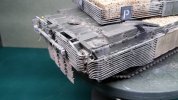malvern_man
SMF Supporter
Hi all,
As photo etched parts are all new to me I have a question or two about them.
I have a 1/35 Tamiya Willys MB Jeep that I will be building some time in the future and I have seen that there are some photo etched parts available for it, so, my questions are...
• what are the pros and cons of PE parts
• do you need a special glue to attach them
• do you treat them like plastic parts when it becomes time for priming and painting
Regards, Chris.
As photo etched parts are all new to me I have a question or two about them.
I have a 1/35 Tamiya Willys MB Jeep that I will be building some time in the future and I have seen that there are some photo etched parts available for it, so, my questions are...
• what are the pros and cons of PE parts
• do you need a special glue to attach them
• do you treat them like plastic parts when it becomes time for priming and painting
Regards, Chris.

